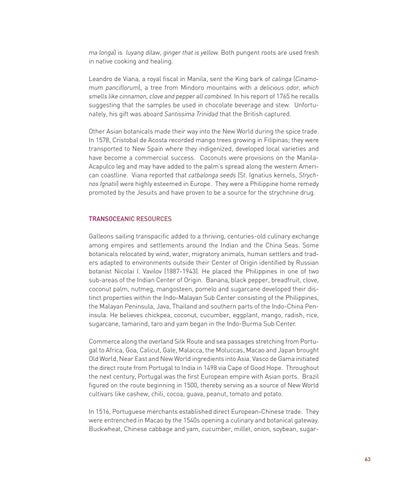ma longa) is luyang dilaw, ginger that is yellow. Both pungent roots are used fresh in native cooking and healing. Leandro de Viana, a royal fiscal in Manila, sent the King bark of calinga (Cinamomum panciflorum), a tree from Mindoro mountains with a delicious odor, which smells like cinnamon, clove and pepper all combined. In his report of 1765 he recalls suggesting that the samples be used in chocolate beverage and stew. Unfortunately, his gift was aboard Santissima Trinidad that the British captured. Other Asian botanicals made their way into the New World during the spice trade. In 1578, Cristobal de Acosta recorded mango trees growing in Filipinas; they were transported to New Spain where they indigenized, developed local varieties and have become a commercial success. Coconuts were provisions on the ManilaAcapulco leg and may have added to the palm’s spread along the western American coastline. Viana reported that catbalonga seeds (St. Ignatius kernels, Strychnos Ignatii) were highly esteemed in Europe. They were a Philippine home remedy promoted by the Jesuits and have proven to be a source for the strychnine drug.
TRANSOCEANIC RESOURCES Galleons sailing transpacific added to a thriving, centuries-old culinary exchange among empires and settlements around the Indian and the China Seas. Some botanicals relocated by wind, water, migratory animals, human settlers and traders adapted to environments outside their Center of Origin identified by Russian botanist Nicolai I. Vavilov (1887-1943). He placed the Philippines in one of two sub-areas of the Indian Center of Origin. Banana, black pepper, breadfruit, clove, coconut palm, nutmeg, mangosteen, pomelo and sugarcane developed their distinct properties within the Indo-Malayan Sub Center consisting of the Philippines, the Malayan Peninsula, Java, Thailand and southern parts of the Indo-China Peninsula. He believes chickpea, coconut, cucumber, eggplant, mango, radish, rice, sugarcane, tamarind, taro and yam began in the Indo-Burma Sub Center. Commerce along the overland Silk Route and sea passages stretching from Portugal to Africa, Goa, Calicut, Gale, Malacca, the Moluccas, Macao and Japan brought Old World, Near East and New World ingredients into Asia. Vasco de Gama initiated the direct route from Portugal to India in 1498 via Cape of Good Hope. Throughout the next century, Portugal was the first European empire with Asian ports. Brazil figured on the route beginning in 1500, thereby serving as a source of New World cultivars like cashew, chili, cocoa, guava, peanut, tomato and potato. In 1516, Portuguese merchants established direct European-Chinese trade. They were entrenched in Macao by the 1540s opening a culinary and botanical gateway. Buckwheat, Chinese cabbage and yam, cucumber, millet, onion, soybean, sugar-
63
03 CAPĂ?TULO 2 INGLES.indd 63
11/11/2016 20:02:32
